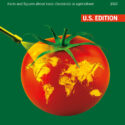Communities are waking up to the hidden threats of pesticide use and building momentum to do something about it.
by Anna Lappé, Earth Island Journal
Instructions on the packaging of Monsanto’s biggest-selling weed killers Roundup and RangerPro tell you to wear long-sleeved shirts, long pants, shoes, and socks. They tell you to wash your hands before “eating, drinking, chewing gum, using tobacco, or using the toilet.” But there is no warning that exposure to even trace amounts of these pesticides may cause terminal cancer. Nor will you be told that the World Health Organization ruled in 2015 that glyphosate, the active ingredient in these weed killers, is a probable human carcinogen.
But in the wake of the first successful legal case tying these products to health risks, more people are becoming aware of their toxicity. In August 2018, a jury in San Francisco Superior Court found Monsanto responsible for its failure to warn users about the risk of RangerPro and Roundup, and determined the company knew or should have known about these risks. The jury awarded school groundskeeper Dwayne “Lee” Johnson $289 million, finding that exposure to Monsanto’s weed-killer was a substantial factor in causing his cancer. More than 8,000 people are engaged in legal cases against Monsanto, which has been acquired by chemical giant, Bayer.
Despite the verdict, glyphosate-based products like Roundup and RangerPro are still widely used in landscaping, from elementary schools to colleges, from road medians to playgrounds. The good news is communities are waking up to the hidden threats of pesticide use and building momentum to do something about it.
The Organic Consumers Association, which had been asking retailers to stop carrying Roundup for years, is launching a campaign to inspire school districts to go herbicide-free. “The examples are out there of school districts that show it can be done,” says Katherine Paul, the group’s associate director.
A movement is brewing on college campuses, too, tapping into concerns among students. My former intern, Mackenzie Feldman, is one of them. Her interest in this issue started several years ago at a UC Berkeley Beach Volleyball practice. “I showed up and my coach said: ‘If you shank any balls [volleyball talk for passing a ball off the court], don’t chase it. Groundskeepers have just sprayed here.’”
She was stunned. The incident prompted Feldman and teammate Bridget Gustafson to launch an herbicide-free UC Berkeley campaign. They galvanized students and met with campus officials, including the school’s grounds manager, who expressed a willingness to try something different. And they helped secure a grant from Beyond Pesticides, a national organization that helps communities transition away from toxic pesticides.
First up: highly trafficked places like the school’s popular lawns, Memorial Glade and Faculty Glade. Every day, thousands of people use these fields or walk by them: Coeds lie on the grass; babies, dogs, and students play on the fields. My daughters’ elementary school picnics there on field trips to campus.
Beyond Pesticides board member Chip Osborne, a professional horticulturalist, was brought in to teach UC groundskeepers a new way of managing turf to prevent weeds from growing. The key is to avoid “regrettable substitutions,” swapping out glyphosate for something equally, or more, toxic. “We want to discourage a ‘product-centered approach,’” explains Drew Toher, Beyond Pesticides’ community resource and policy director. “Instead, we promote a systems-based one, which focuses on enhancing soil biology to promote healthy landscaping.”
Today, the two main green spaces on campus are on their way to being herbicide-free; the beach volleyball court already is. And Feldman, who has since graduated, is developing a campaign to inspire the entire UC system to rethink its reliance on toxic herbicides in grounds management.
In the wake of the Johnson ruling, there will be more Mackenzie Feldmans: People who look around their communities and ask, Why? Why are we using toxic chemicals when there are solutions at our fingertips that carry no risk at all? There is no comprehensive list of every city, campus, or school district that has passed a pesticide-free policy, but Beyond Pesticides has been trying to track them: To date, their tally totals 155 local ordinances that address some aspect of pesticide management on public lands. And there will surely be many more cities and schools that get inspired by this vision of a toxic-free future — yours could be next.
Header photo by Kelly Sikkema




